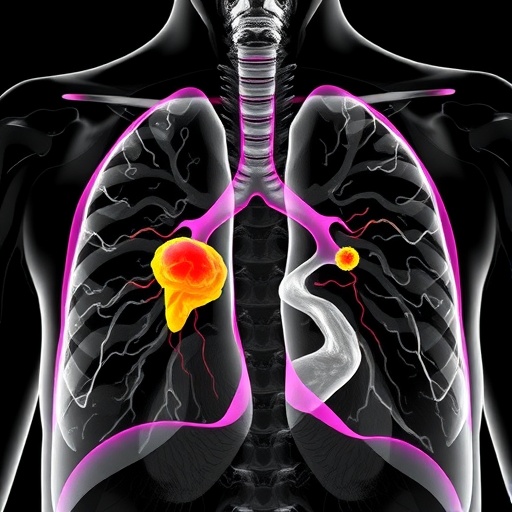In a groundbreaking advancement poised to revolutionize oncological radiotherapy, researchers have unveiled a novel deep learning model that autonomously contours gross tumor volume lymph nodes (GTVnd) in lung cancer patients with remarkable accuracy. Published in the prestigious journal BMC Cancer, this pioneering study addresses a critical bottleneck in lung cancer treatment planning: the precise and efficient delineation of lymph node metastases, which has traditionally demanded extensive manual effort and expertise.
Lymph node involvement in lung cancer represents a pivotal factor influencing prognosis and therapeutic strategy. Accurate contouring of GTVnd directly impacts clinical target volume delineation, which, in turn, governs radiation dose distribution. However, manual segmentation is notoriously time-consuming, highly variable between clinicians, and prone to subjective errors. Recognizing these challenges, the research team sought to harness the power of deep learning to automate this essential step in radiotherapy workflows.
The study leveraged a dataset comprising ninety computed tomography (CT) scans from patients diagnosed with advanced stage III to IV small cell lung cancer (SCLC). Of these, seventy-five scans were allocated for model training, with the remaining fifteen reserved for rigorous testing. This balance ensured the algorithm was both exposed to a diverse set of anatomical and pathological presentations and subsequently validated on unseen cases, reflecting real-world variability.
At the heart of this innovation lies a custom-designed neural network, coined ECENet, which incorporates two sophisticated components: a contextual cue enhancement module and an edge-guided feature enhancement decoder. The former serves to bolster the consistency and semantic integrity of the deep feature representations, ensuring that the model captures nuanced spatial relationships within the complex thoracic anatomy. Meanwhile, the decoder specializes in producing edge-aware segmentations that preserve the intricate boundaries of lymph nodes, a notoriously difficult feature to grasp given their often irregular and diffuse margins.
Quantitative evaluation of ECENet’s performance was meticulous and exhaustive. The model attained a mean three-dimensional Dice Similarity Coefficient (3D DSC) of 0.72 with a standard deviation of 0.09, illustrating a high level of overlap between automated and ground truth contours. Furthermore, the 95th percentile Hausdorff Distance (95HD) averaged at 6.39 millimeters (± 4.59 mm), representing a significant reduction in boundary error compared to traditional models. To contextualize these results, ECENet’s performance outpaced notable baselines like the established UNet and nnUNet architectures, which respectively scored DSCs of 0.46 ± 0.19 and 0.52 ± 0.18.
Intriguingly, the model’s accuracy situates it between the performance levels of mid-level and junior radiation oncologists, with the former achieving a DSC of 0.81 and the latter 0.68. This intermediary positioning suggests that ECENet could serve as a valuable assistant tool, particularly aiding less experienced clinicians in tumor contouring without supplanting expert judgment.
Beyond purely geometric metrics, the researchers conducted a sophisticated comparison of dosimetric treatment plans derived from automatic contours versus those based on manual delineations. The dosimetric analysis revealed negligible differences—average relative deviations fell below 0.17% for key planning target volume (PTV) dose metrics such as D2, D50, and D98, and remained under 3.5% for critical lung dose-volume parameters (V30, V20, V10, V5, and mean dose). Similarly, heart dose parameters manifested deviations less than 6.1%.
Of paramount importance, tumor control probability (TCP) and normal tissue complication probability (NTCP) analyses echoed these findings. Predicted plans generated from automated contours demonstrated consistent TCP values around 67% and NTCP values near 3%, closely mirroring clinically generated plans. This alignment substantiates the clinical viability of ECENet-informed workflows, asserting confidence that automated segmentation will neither compromise therapeutic efficacy nor elevate risks of adverse effects.
The implications of this research are profound. As radiation oncology continues its paradigm shift towards precision medicine, tools that streamline workflow and enhance consistency are indispensable. ECENet’s ability to autonomously and accurately delineate GTVnd could drastically reduce contouring time, alleviate clinician workload, and minimize inter-observer variability—factors that cumulatively contribute to improved patient outcomes and resource utilization.
Moreover, the model’s application extends beyond mere segmentation; its integration within treatment planning systems holds promise for real-time adaptive radiotherapy protocols. Such protocols require rapid re-contouring to adjust to tumor shrinkage or anatomical changes, thereby optimizing dose delivery dynamically throughout the course of therapy.
While this study focused specifically on small cell lung cancer, the architecture and methodology piloted here present a framework readily adaptable to other malignancies with lymph node involvement. Future research will undoubtedly investigate its generalizability across broader cancer types and clinical scenarios, enhancing its impact.
It is also important to highlight that the model’s development underscored the fusion of advanced computational techniques with clinical expertise. The design of the contextual cue enhancement and edge-guided decoding modules reflects an intricate understanding of both the imaging data characteristics and the pathophysiology of lymphatic spread.
Despite these promising outcomes, the authors acknowledge areas for refinement. Larger, multi-institutional datasets might help bolster the algorithm’s robustness and mitigate biases inherent in single-center studies. Additionally, real-world deployment will necessitate seamless integration with existing clinical workflows and user interfaces to maximize adoption.
In conclusion, ECENet marks a significant stride in the automation of complex radiotherapy tasks. By marrying deep learning innovations with clinical necessities, this technology heralds a new era wherein young radiation oncologists are empowered with tools that augment their capabilities, enabling faster, more precise tumor delineation. Such advancements pave the way for enhanced lung cancer care and potentially elevate survival outcomes across diverse patient populations.
Subject of Research:
Automatic segmentation and contouring of gross tumor volume lymph nodes in lung cancer patients using deep learning.
Article Title:
Automated contouring of gross tumor volume lymph nodes in lung cancer by deep learning.
Article References:
Huang, Y., Yuan, X., Xu, L. et al. Automated contouring of gross tumor volume lymph nodes in lung cancer by deep learning. BMC Cancer 25, 1444 (2025). https://doi.org/10.1186/s12885-025-14794-6
Image Credits:
Scienmag.com




